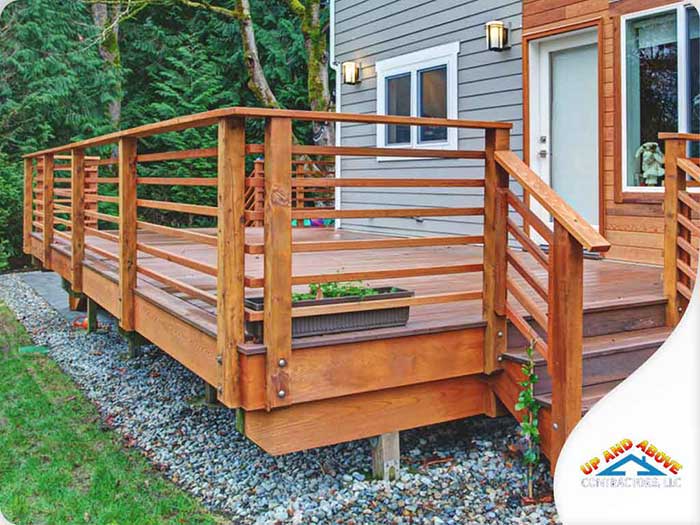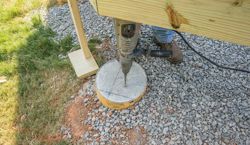Step-by-Step Deck Quality: Making Sure Stability with Effectively Installed Deck Footings
Step-by-Step Deck Quality: Making Sure Stability with Effectively Installed Deck Footings
Blog Article
Selecting the Right Deck Footings for Security and Durability
When it pertains to building a deck, one of the most essential choices you will certainly make is selecting the ideal footings for stability and resilience. The durability and security of your deck depend heavily on the kind of grounds you select, as they offer the necessary assistance and security to withstand the test of time. With a myriad of options available, it can be frustrating to figure out which footings are best fit for your particular demands. In this conversation, we will certainly explore the various sorts of deck footings, consider the crucial factors to consider when making a decision, and explore the pros and cons of various alternatives. By the end, you will have a more clear understanding of the choices handy and be much better equipped to make a notified choice for your deck project.
Sorts Of Deck Grounds
These grounds are composed of a round opening loaded with concrete, which supplies a strong structure for the deck blog posts. Concrete pier grounds are fairly simple to mount and offer superb security, making them a prominent selection for several deck tasks.
An additional sort of footing is the helical stack footing. Helical heaps are steel shafts with helical plates affixed to them. These grounds are installed by screwing them right into the ground, which produces a protected structure for the deck. Helical heap grounds are perfect for locations with difficult soil conditions, as they can be mounted in practically any kind of dirt. If required., they likewise enable for very easy modification and leveling of the deck.
Alternatively, some contractors go with precast concrete footings. These footings are constructed from long lasting concrete and be available in different shapes and dimensions to fit various deck layouts. Precast concrete grounds are convenient to mount and supply a steady base for the deck framework.
Ultimately, an additional option is the post-in-anchor ground system. This type of footing includes driving a steel anchor into the ground and connecting it to the deck blog post. It provides flexibility in regards to placing the deck messages and is suitable for decks with lightweight frameworks.
When selecting the best sort of deck footing, it is important to take into consideration elements such as soil problems, deck tons, and local building ordinance (Deck Footings). Consulting with an expert service provider or structural designer can assist make sure the proper footing is selected for a secure and secure deck
Variables to Think About When Selecting Footings
When choosing the proper grounds for a deck, it is essential to meticulously think about various factors such as soil problems, deck tons, and adherence to neighborhood building regulations. These factors play a significant role in making sure the stability and resilience of the deck framework.
One of the key variables to consider is the soil problems. The type of soil on which the deck will be developed figures out the kind of grounds called for. As an example, decks developed on loosened or sandy dirts might require deeper footings to give ample support and protect against settling. On the various other hand, decks developed on clay or expansive dirts might call for grounds that can accommodate the soil's tendency to increase and agreement.
An additional vital factor is the deck tons. The weight of the deck, consisting of the products utilized and any potential live loads such as furnishings or gatherings, have to be taken into consideration when choosing grounds. The grounds must be developed to bear the weight of the deck and distribute it equally to avoid any type of structural concerns or failings.
Finally, adherence to neighborhood building ordinance is paramount. Building regulations vary from region to region, and it from this source is essential to follow the details demands established by the regional authorities. Deck Footings. These codes guarantee that the deck is developed securely and fulfills the required criteria for structural honesty and load-bearing capacity
Concrete Grounds: Advantages And Disadvantages

Concrete footings provide numerous benefits and drawbacks when utilized as the structure for a deck. On the positive side, concrete footings give superb stability and sturdiness.
Another benefit of concrete footings is their you could check here flexibility. They can be put into various sizes and shapes to fit various deck layouts and configurations. Concrete footings can be personalized to fit the details needs and requirements of the deck framework.
However, there are also some disadvantages to making use of concrete grounds. This can enhance the overall expense of the deck job and might require specialist aid.

Helical Piers Vs. Sonotubes: Which Is Much better?
In considering the structure alternatives for a deck, the contrast in between helical piers and sonotubes is critical in establishing the exceptional selection. Helical piers, likewise called screw stacks, are steel shafts with helical plates connected to them. They are turned into the ground making use of hydraulic machinery, supplying a durable and secure foundation for the deck. On the various other hand, sonotubes are cylindrical types constructed from cardboard or fiber product that are loaded with concrete. They are put in a hole dug into the ground and offer assistance for the deck.
The helical plates on the piers develop a solid grip with the soil, changing or avoiding any type of activity of the deck. Sonotubes, on the other hand, count solely on the concrete loading for security, which may not offer the very same level of strength and resistance.
In regards to setup, helical piers are reasonably much easier and faster to set up compared to sonotubes. The hydraulic machinery utilized to turn the Our site piers into the ground ensures a reliable and quick procedure. Sonotubes, on the other hand, need digging openings and pouring concrete, which can be labor-intensive and taxing.
Furthermore, helical piers are an even more versatile option. They can be utilized in numerous dirt conditions and can be readjusted or enhanced if required. Sonotubes, on the other hand, may call for added support, such as rebar, in particular soil conditions or locations with high load needs.
Choosing the Right Footings for Your Deck's Dimensions
For optimum architectural stability, it is vital to thoroughly pick the ideal footings that line up with the dimensions of your deck. The dimensions of your deck, including its height, width, and size, play a significant role in figuring out the kind and dimension of footings required.
When choosing grounds for your deck, it is necessary to take into consideration the load-bearing capacity of the soil. The weight of the deck, incorporated with the weight of any kind of furniture or individuals on it, exerts a significant force on the footings (Deck Footings). It is vital to pick footings that can properly sustain this weight without sinking or changing over time.
Bigger decks with higher measurements call for larger grounds to offer enough security and assistance. The form of the grounds, whether they are rounded or square, depends on the design and layout of the deck.
Conclusion
In verdict, picking the best deck grounds is critical for making certain security and resilience. Variables such as the type of footings, the deck's measurements, and the pros and disadvantages of different alternatives should be thought about.
These footings consist of a cylindrical hole filled with concrete, which provides a strong structure for the deck messages. Concrete pier grounds are fairly easy to install and use superb security, making them a prominent option for many deck projects.
Precast concrete grounds are convenient to install and supply a secure base for the deck framework.
It uses flexibility in terms of positioning the deck blog posts and is ideal for decks with light-weight structures.
Concrete grounds provide several benefits and drawbacks when made use of as the foundation for a deck.
Report this page